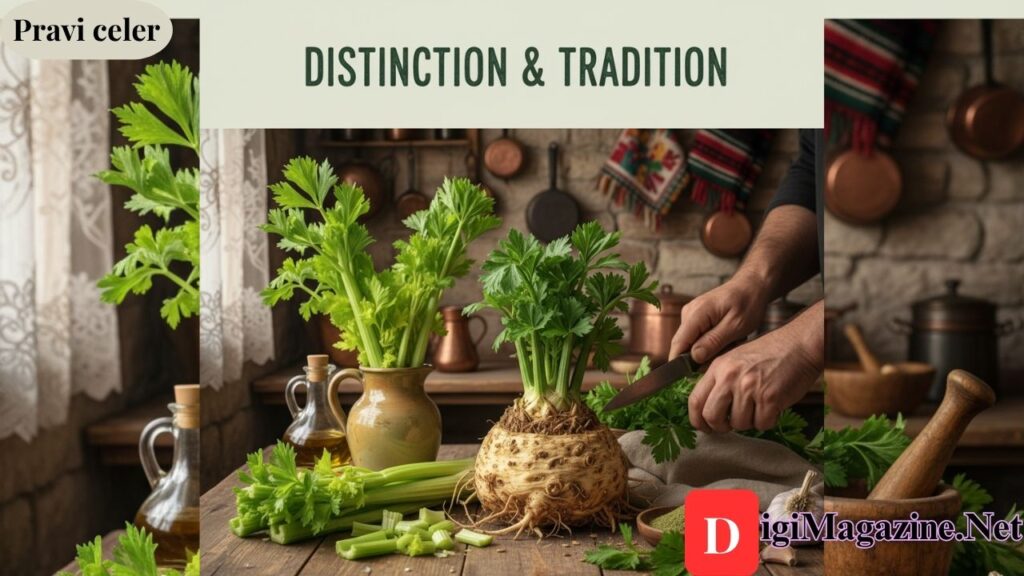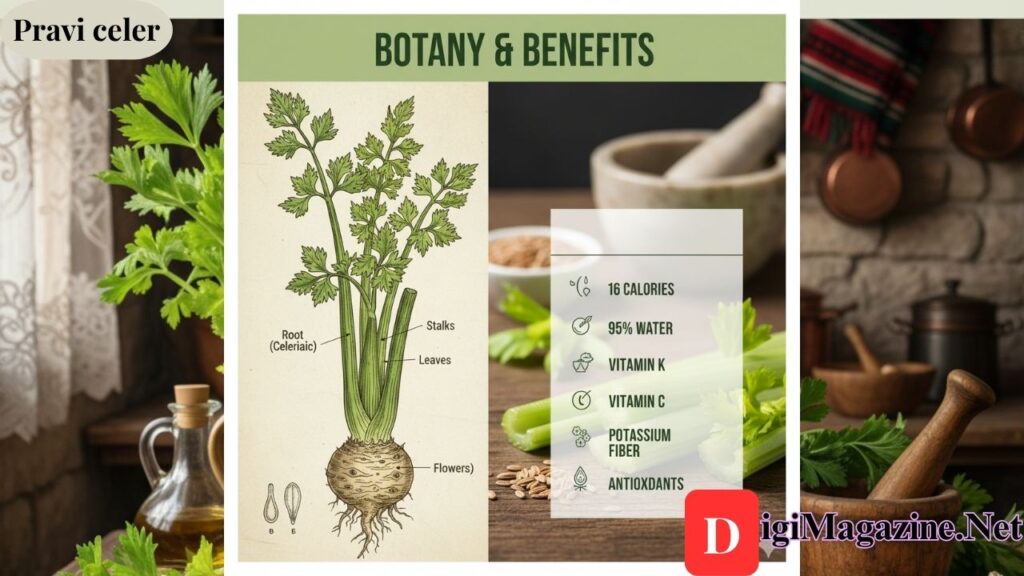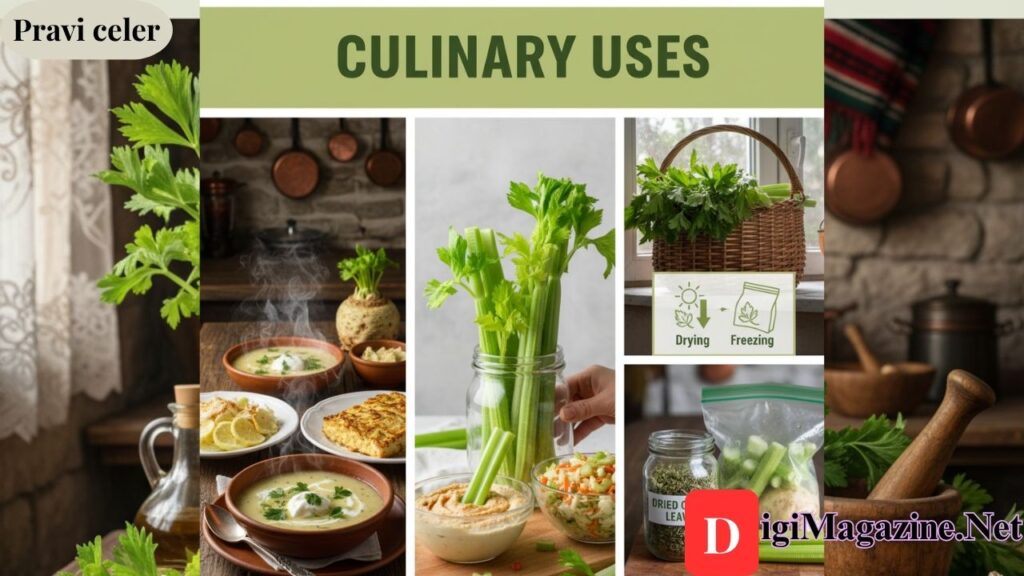Introduction to Pravi Celer
Pravi celer, known scientifically as Apium graveolens, holds a special place in Balkan kitchens and gardens. This versatile vegetable has been cultivated for centuries, offering both culinary delights and nutritional benefits that have made it a staple ingredient across the region.
What is Pravi Celer?
True celery refers to the authentic celery plant that grows in two distinct forms. Many home cooks and gardeners appreciate this vegetable for its aromatic leaves, crunchy stalks, and flavorful roots. The plant belongs to the Apiaceae family and has been used in cooking and traditional medicine throughout history.
Distinction Between Celery Varieties

Understanding the difference between celery types helps cooks choose the right variety for their recipes. Stalk celery features long, crisp stems that grow above ground, perfect for fresh salads and snacking. Celeriac, on the other hand, develops a bulbous root beneath the soil surface, prized for its nutty flavor and dense texture. Both varieties come from the same plant species but offer unique culinary applications.
Historical Background and Origin
The cultivation of celery dates back thousands of years to the Mediterranean region. Ancient Greeks and Romans valued the plant not only as food but also for ceremonial purposes. Over time, farmers selectively bred wild celery to develop the milder, more palatable varieties enjoyed today. The vegetable made its way through Europe, becoming particularly beloved in Balkan countries where it integrated seamlessly into traditional cooking methods.
Cultural Significance in Balkan Cuisine
In Serbian, Croatian, and Bosnian kitchens, this vegetable represents comfort and tradition. Families pass down recipes featuring the aromatic vegetable from generation to generation. Winter soups, hearty stews, and flavorful broths simply wouldn’t taste the same without their distinctive flavor. The plant’s presence in markets throughout the colder months signals the arrival of soup season, bringing warmth to homes across the Balkans.
Botanical Characteristics

Plant Description and Growth Habits
The celery plant displays distinctive features that make it recognizable in any garden. Its compound leaves grow in clusters, with each leaf divided into smaller leaflets that emit a strong, pleasant aroma when crushed. The plant typically reaches heights between 30 to 60 centimeters, depending on the variety and growing conditions. During its second year, the plant produces small white or greenish flowers arranged in umbrella-shaped clusters.
Root vs. Stalk Varieties
Root varieties develop thick, knobby underground bulbs covered in rough, brown skin. These roots can grow quite large, sometimes reaching the size of a softball. The flesh inside remains creamy white with a concentrated flavor. Stalk varieties focus their energy on producing crisp, ribbed stems that grow tightly together in bunches. The stalks range in color from pale green to deep emerald, with inner stalks remaining lighter and more tender.
Growing Seasons and Climate Requirements
This cool-season crop thrives in moderate temperatures between 15 to 21 degrees Celsius. The plant requires a long growing season, typically 120 to 180 days from seed to harvest. In regions with mild winters, gardeners can plant in late summer for a winter harvest. Areas with harsh winters see spring planting for fall harvest. The vegetable tolerates light frosts, which actually enhance its flavor by converting starches to sugars.
Nutritional Profile and Health Benefits
From a nutritional standpoint, this vegetable packs impressive benefits into relatively few calories. A 100-gram serving contains approximately 16 calories while providing vitamin K, vitamin C, potassium, and folate. The vegetable also supplies dietary fiber, supporting digestive health. Its high water content—about 95 percent—makes it naturally hydrating. Antioxidants present in the plant help protect cells from damage, while minerals like calcium and magnesium support bone health.
Culinary Uses

Traditional Balkan Recipes Featuring Celer
Balkan cooks have perfected numerous dishes that showcase the vegetable’s versatility. Root varieties often appear in winter salads, thinly sliced or grated and dressed with lemon juice and oil. The vegetable stars in casseroles, baked until tender and golden. Pickled preparations preserve the harvest, providing tangy accompaniments to rich meats throughout the winter months.
Celer Soup (Čorba od Celera)
This beloved soup represents ultimate comfort food in many households. Cooks begin by sautéing diced roots with onions and carrots until fragrant. They add vegetable or chicken stock, allowing everything to simmer until tender. Some versions incorporate potatoes for extra heartiness, while others keep it simple to highlight the vegetable’s natural flavor. A finishing touch of sour cream and fresh parsley creates a velvety, satisfying meal perfect for cold evenings.
Use in Stocks and Broths
Professional chefs and home cooks alike rely on this aromatic vegetable as a foundation for flavorful liquids. The classic mirepoix—a combination of diced vegetables—includes it alongside onions and carrots. These three ingredients create depth and complexity in everything from simple vegetable stocks to rich meat-based broths. The leaves, often discarded by inexperienced cooks, actually contain the most intense flavor and should be added during the final stages of cooking.
Raw vs. Cooked Applications
Fresh stalks provide a satisfying crunch in raw preparations. They pair beautifully with creamy dips, offering a vehicle for hummus, ranch dressing, or cream cheese spreads. Thinly sliced stalks add texture to slaws and salads. Cooking transforms the vegetable’s character entirely. Heat mellows its sharp notes while bringing out subtle sweetness. Braised preparations turn fibrous stalks silky and tender. Roasting caramelizes natural sugars, creating depth of flavor.
Preservation Methods
Drying preserves the vegetable’s essence for year-round use. Gardeners harvest leaves at their peak, spreading them in thin layers in well-ventilated areas away from direct sunlight. Once completely dry, they crumble easily and can be stored in airtight containers. This dried version adds instant flavor to soups and stews. Freezing works well for roots and stalks intended for cooked dishes. Blanching before freezing helps maintain color and texture, though frozen vegetables work best in preparations where texture isn’t crucial.
Growing Pravi Celer
Soil and Sunlight Requirements
Success begins with proper site selection. The plant prefers rich, moisture-retentive soil high in organic matter. Gardeners should work plenty of compost or well-rotted manure into planting beds before sowing seeds. The soil pH should range between 6.0 and 7.0 for optimal growth. While the plant tolerates partial shade, it performs best with at least six hours of sunlight daily. In particularly hot climates, afternoon shade prevents stress during peak summer heat.
Planting Techniques
Seeds require patience, as germination can take two to three weeks under ideal conditions. Many gardeners start seeds indoors eight to ten weeks before the last expected frost. The tiny seeds need light to germinate, so they should be pressed onto the soil surface rather than buried deeply. Transplanting seedlings outdoors requires hardening off—gradually exposing them to outdoor conditions over seven to ten days. Space plants 25 to 30 centimeters apart to allow adequate air circulation.
Watering and Fertilization Needs
Consistent moisture proves critical for healthy development. The shallow root system means the plant cannot access deep water reserves during dry periods. Gardeners should aim to provide 2.5 to 5 centimeters of water weekly through rainfall or irrigation. Mulching around plants helps retain soil moisture while suppressing weeds. The heavy-feeding vegetable benefits from regular fertilization. Applying a balanced fertilizer every three to four weeks supports steady growth and prevents nutrient deficiencies.
Common Pests and Diseases
Several pests find this vegetable particularly appealing. Aphids cluster on tender new growth, sucking plant juices and potentially spreading diseases. Strong water sprays dislodge these soft-bodied insects, while insecticidal soap provides control for persistent infestations. Leaf miners create winding tunnels in foliage, though damage remains mostly cosmetic. Root crops face threats from carrot rust flies, whose larvae tunnel into roots. Row covers prevent adult flies from laying eggs near plants. Fungal diseases like leaf spot and blight occur in humid conditions with poor air circulation.
Harvesting Tips and Timing
Knowing when to harvest ensures the best flavor and texture. Stalk varieties reach maturity when bunches achieve full size and stalks maintain firmness. Gardeners can harvest individual outer stalks as needed or cut entire plants at the soil level. Root varieties require patience, as they develop flavor best after experiencing some cool weather. Most roots reach harvest size three to four months after transplanting. Digging should occur before hard freezes, though light frosts improve flavor. Using a garden fork prevents damage to the knobby roots during harvest.
Health Benefits
Vitamins and Minerals Content
This nutritious vegetable delivers essential nutrients that support overall health. Vitamin K plays crucial roles in blood clotting and bone metabolism. A single serving provides a significant portion of daily vitamin K needs. Vitamin C acts as an antioxidant, supporting immune function and collagen production. The potassium content helps regulate blood pressure and supports heart health. Folate proves especially important for pregnant women, as it supports fetal development and prevents certain birth defects.
Anti-Inflammatory Properties
Compounds found in the plant demonstrate anti-inflammatory effects in research studies. Antioxidants like flavonoids and polyphenols help reduce inflammation throughout the body. Chronic inflammation links to numerous health conditions, including heart disease, diabetes, and arthritis. Regular consumption of anti-inflammatory foods may help manage these conditions and promote overall wellness. The vegetable’s phytonutrients work together synergistically, potentially offering greater benefits than isolated compounds.
Digestive Health Benefits
The dietary fiber content supports healthy digestion in multiple ways. Fiber adds bulk to stool, promoting regular bowel movements and preventing constipation. It also feeds beneficial gut bacteria, supporting a healthy microbiome. A balanced gut microbiome influences everything from immune function to mental health. The vegetable’s high water content further aids digestion, helping food move smoothly through the digestive tract. People dealing with bloating or irregular digestion often find relief through increased vegetable consumption.
Traditional Medicinal Uses
Folk medicine traditions across cultures have utilized this plant for various ailments. Herbalists historically recommended it for joint pain and arthritis symptoms. Traditional practitioners prepared teas from seeds to address digestive complaints and promote kidney function. Some cultures believed the vegetable possessed calming properties, using it to ease anxiety and promote restful sleep. While modern medicine doesn’t necessarily support all traditional uses, many contain kernels of truth validated by contemporary research.
Dietary Considerations
The low-calorie content makes this vegetable excellent for weight management diets. Its fiber and water content promote feelings of fullness without adding many calories. People following low-sodium diets appreciate its naturally low sodium content—fresh varieties contain only about 80 milligrams per 100 grams. Those managing diabetes benefit from its low glycemic index, meaning it doesn’t cause rapid blood sugar spikes. However, individuals taking blood-thinning medications should maintain consistent vitamin K intake, as fluctuations can affect medication effectiveness.
Selection and Storage
How to Choose Fresh Celery at the Market
Quality selection begins with visual inspection. Stalks should appear crisp and firm, snapping easily when bent. Avoid bunches with wilted or yellowing leaves, which indicate age or improper storage. The stalks should feel heavy for their size, indicating good moisture content. For root varieties, look for firm bulbs without soft spots or excessive surface damage. Smaller to medium-sized roots often offer better texture and flavor than oversized specimens, which can develop woody centers.
Proper Storage Techniques
Refrigeration extends the freshness significantly. Stalks stay crisp longest when wrapped in aluminum foil or placed in perforated plastic bags in the vegetable crisper. This method can maintain quality for two to three weeks. Alternatively, storing stalks upright in a container with water—like a bouquet—keeps them crisp in the refrigerator. Roots prefer cool, humid conditions. Unwashed roots stored in plastic bags in the crisper drawer remain fresh for several weeks. Leaving a bit of soil on roots during storage can extend their shelf life.
Shelf Life Expectations
Fresh stalks typically maintain peak quality for one to two weeks under proper refrigeration. Signs of decline include limpness, browning, and unpleasant odors. Roots demonstrate better longevity, often keeping for three to four weeks or longer when stored correctly. The leaves deteriorate faster than stalks or roots, so many cooks remove and use or dry them soon after purchase. Cut or chopped pieces deteriorate rapidly, losing crispness within a few days even when refrigerated.
Signs of Spoilage
Recognizing spoilage prevents food waste and ensures food safety. Slimy texture on stalks indicates bacterial growth and means the vegetable should be discarded. Brown or black spots spreading across stalks suggest decay. A strong, unpleasant odor clearly signals spoilage. For roots, soft or mushy spots indicate rot, while mold growth on the surface requires discarding the entire root. When in doubt, trust your senses—if something seems off, it probably is.
Pravi Celer in Regional Cuisine
Serbian Traditional Dishes
Serbian cooks incorporate this vegetable into numerous beloved dishes. It appears in sarma—cabbage rolls filled with meat and rice—where it adds aromatic depth to the tomato-based sauce. Thick vegetable soups called čorbe rely on it as a foundational ingredient. Serbian households often prepare root varieties as a standalone side dish, baked with breadcrumbs and cheese until golden. The vegetable also features in winter salads, grated raw and mixed with other root vegetables in refreshing, crunchy combinations.
Croatian Culinary Applications
Croatian cuisine showcases vegetables in both coastal and inland preparations. Dalmatian cooks add it to fish stews and risottos, where it complements seafood flavors. In continental Croatia, it appears in meat-based dishes and hearty soups that sustain families through cold winters. Croatian grandmothers swear by adding it to pasticada, a slow-braised beef dish that represents the pinnacle of special-occasion cooking. The vegetable’s ability to enhance other flavors without overwhelming them makes it indispensable in Croatian kitchens.
Bosnian Cooking Traditions
Bosnian cuisine features this aromatic vegetable prominently in its beloved stews and soups. It forms part of the aromatic base for begova čorba, an elegant chicken soup enriched with vegetables and herbs. Bosnian cooks also prepare it as a standalone dish, stewing diced roots with tomatoes and peppers. During the winter months, markets overflow with vegetables, and families buy them in quantity to make preserves and prepare warming meals. The vegetable’s presence in Bosnian cooking reflects the cuisine’s emphasis on vegetables and balanced, flavorful dishes.
Comparison with Western Celery Usage
Western cuisines generally utilize stalks more prominently than roots. American and British cooks frequently use stalks raw in salads or with dips, treating them primarily as a snack vegetable. Western recipes often call for it as an aromatic base alongside onions and carrots, but rarely feature it as a main ingredient. Balkan cuisines, conversely, celebrate the vegetable in its own right, creating dishes where it stars rather than simply supports. Root varieties receive particular attention in Balkan cooking, while Western cuisines have only recently begun appreciating celeriac’s potential.
For more information, visit Digi Magazine.







